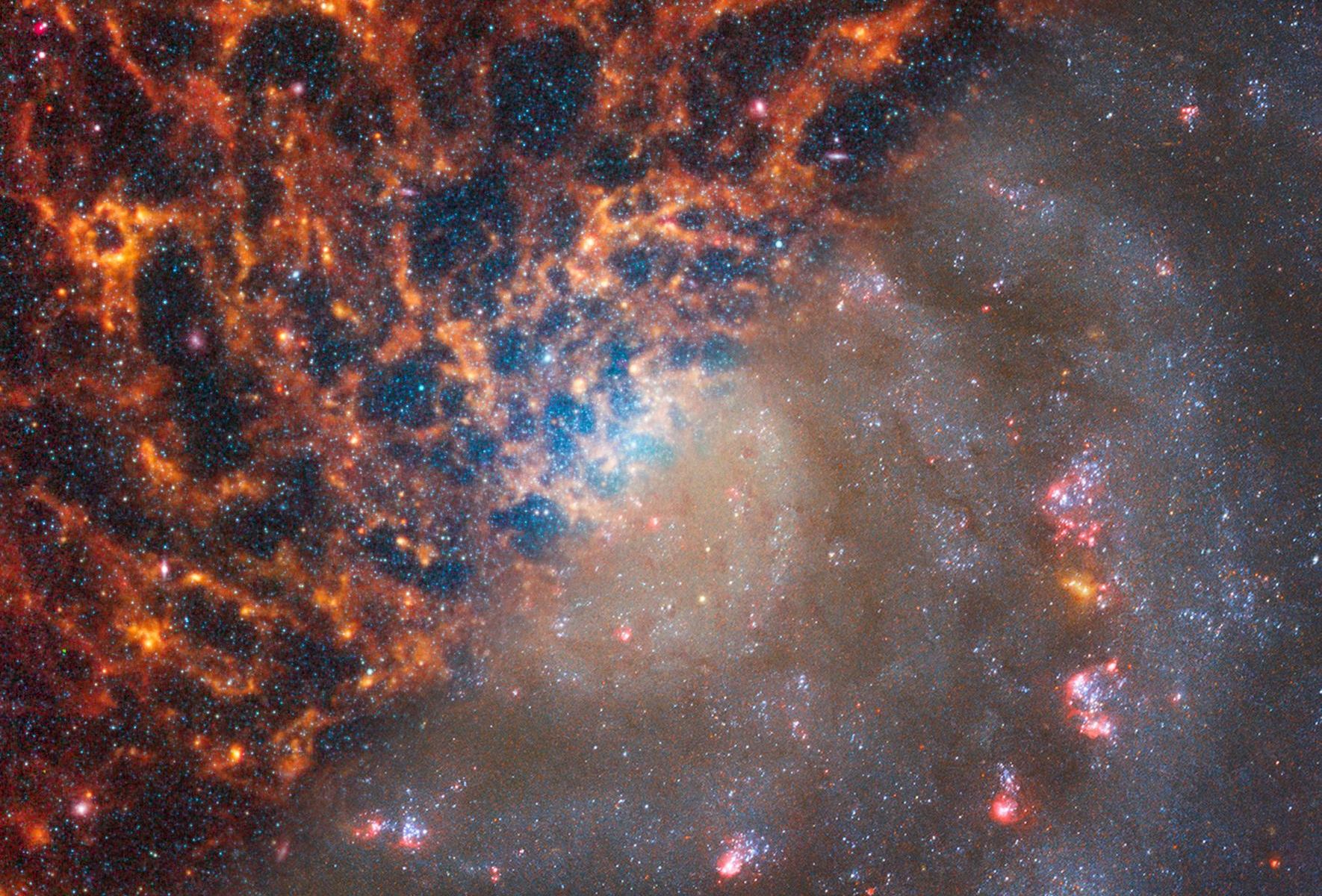The Galaxy is a collection of stars, planets, gas clouds and to the dismay of astronomers, dust clouds. The dust blocks starlight from penetrating so it’s very difficult to learn about the far side of the Galaxy. Thankfully the upcoming Nancy Grace Roman telescope has infrared capability so it can see through the dust. A systematic survey of the far side of the Milky Way is planned to see what’s there and could discover billions of objects in just a month.
Continue reading “Nancy Grace Roman will Map the Far Side of the Milky Way”Another Hycean Planet Found? TOI-270 d

Hycean planets may be able to host life even though they’re outside what scientists consider the regular habitable zone. Their thick atmospheres can trap enough heat to keep the oceans warm even though they’re not close to their stars.
Astronomers have found another one of these potential hycean worlds named TOI-270 d.
Continue reading “Another Hycean Planet Found? TOI-270 d”Starship Reaches Orbit on SpaceX’s Third Test but Breaks Up on Re-Entry
After falling short in its first two attempts, SpaceX got its Starship super-rocket to an orbital altitude today during the launch system’s third integrated flight test. Now it just has to work on the landing.
Today’s test marked a major milestone in SpaceX’s effort to develop Starship as the equivalent of a gigantic Swiss Army knife for spaceflight, with potential applications ranging from the deployment of hundreds of Starlink broadband satellites at a time to crewed odysseys to the moon, Mars and beyond.
Continue reading “Starship Reaches Orbit on SpaceX’s Third Test but Breaks Up on Re-Entry”NASA and Boeing Release New Rendering of their X-66 Sustainable Experimental Airliner

Climate change is arguably the single greatest threat facing the world today. According to the Sixth Assessment Report (AR6) by the UN Intergovernmental Panel on Climate Change (IPCC), average global temperatures are set to increase between 1.5 and 2 °C (2.7 to 3.6 °F) by mid-century. To restrict global temperatures to an increase of 1.5 C and avoid the worst-case scenarios, the nations of the world need to achieve net zero emissions by then. Otherwise, things will get a lot worse before they get better, assuming they ever do.
This means transitioning to cleaner methods in terms of energy, transportation, and aviation. To meet our climate commitments, the aviation industry is developing technology to significantly reduce air travel’s carbon footprint. To help meet this goal, NASA and Boeing have come together to create the X-66 Sustainable Experimental Airliner, the first experimental plane specifically focused on helping the U.S. achieve net-zero aviation. Last week, NASA released a new rendering of the concept, giving the public an updated look at the future of air travel.
Continue reading “NASA and Boeing Release New Rendering of their X-66 Sustainable Experimental Airliner”Webb Sees a Star-Forming Region Blowing Vast Bubbles

Star birth is a messy and chaotic event. Some of the process remains well hidden behind clouds of gas and dust that make up star-forming regions. However, part of it happens in wavelengths of light we can detect, such as visible light and infrared. It’s an intricate process that the Webb telescope (JWST) can study in detail.
Continue reading “Webb Sees a Star-Forming Region Blowing Vast Bubbles”What Can We Learn Flying Through the Plumes at Enceladus?

In the next decade, space agencies will expand the search for extraterrestrial life beyond Mars, where all of our astrobiology efforts are currently focused. This includes the ESA’s JUpiter ICy moon’s Explorer (JUICE) and NASA’s Europa Clipper, which will fly past Europa and Ganymede repeatedly to study their surfaces and interiors. There’s also NASA’s proposed Dragonfly mission that will fly to Titan and study its atmosphere, methane lakes, and the rich organic chemistry happening on its surface. But perhaps the most compelling destination is Enceladus and the lovely plumes emanating from its southern polar region.
Since the Cassini mission got a close-up look at these plumes, scientists have been aching to send a robotic mission there to sample them – which appear to have all the ingredients for life in them. This is not as easy as it sounds, and there’s no indication flying through plumes will yield intact samples. In a recent paper, researchers from the University of Kent examined how the velocity of a passing spacecraft (and the resulting shock of impact) could significantly affect its ability to sample water and ice within the plumes.
Continue reading “What Can We Learn Flying Through the Plumes at Enceladus?”NASA Announces its 2025 Budget. Lean Times Ahead.
Space flight is an expensive business and that money has to come from somewhere. The White House has just released their budget for fiscal year 2025. What does that mean for NASA?, they will get $25.4 billion, the same as it received last year but $2 billion less than it requested. NASA Administrator Bill Nelson said the constraints come from a debt ceiling agreement that limits non-defence spending. Alas the $2 billion deficit means NASA will need to cut costs from various missions.
Continue reading “NASA Announces its 2025 Budget. Lean Times Ahead.”A 790,000 Year-Old Asteroid Impact Could Explain Seafloor Spherules
Our solar system does not exist in isolation. It formed within a stellar nursery along with hundreds of sibling stars, and even today has the occasional interaction with interstellar objects such as Oumuamua and Borisov. So it’s reasonable to presume that some interstellar material has reached Earth. Recently Avi Loeb and his team earned quite a bit of attention with a study arguing that it had found some of this interstellar stuff on the ocean seabed. But a new study finds that the material has a much more local origin.
Continue reading “A 790,000 Year-Old Asteroid Impact Could Explain Seafloor Spherules”Ultrablack Coating Could Be Ideal for Telescopes

If you, like me, have dabbled with telescope making you will know what a fickle friend light can be. On one hand you want to capture as much as you can (but only from the object, not from nearby lights) and want to reflect or refract it to the point of observation or study. What you most certainly don’t want is stray light to be bounced around inside the telescope so components (except the mirror!) are sprayed as black as possible. Unfortunately black paints tend to be quite susceptible to damage and struggle to cope with the harsh conditions and cold temperatures telescopes are subjected to. A team has recently developed a new atomic-layer deposition method which absorbs 99.3% of light and is durable too.
Continue reading “Ultrablack Coating Could Be Ideal for Telescopes”Are Andromeda and the Milky Way Already Exchanging Stars?

I often drag out the amazing fact that the Andromeda Galaxy, that faint fuzzy blob just off the corner of the Square of Pegasus, is heading straight for us! Of course I continue to tell people it won’t happen for a few billion years yet but a recent study suggests that we are already seeing hypervelocity stars that have been ejected from Andromeda already. It is just possible that the two galaxies have already started to exchange stars long before they are expected to merge.
Continue reading “Are Andromeda and the Milky Way Already Exchanging Stars?”



